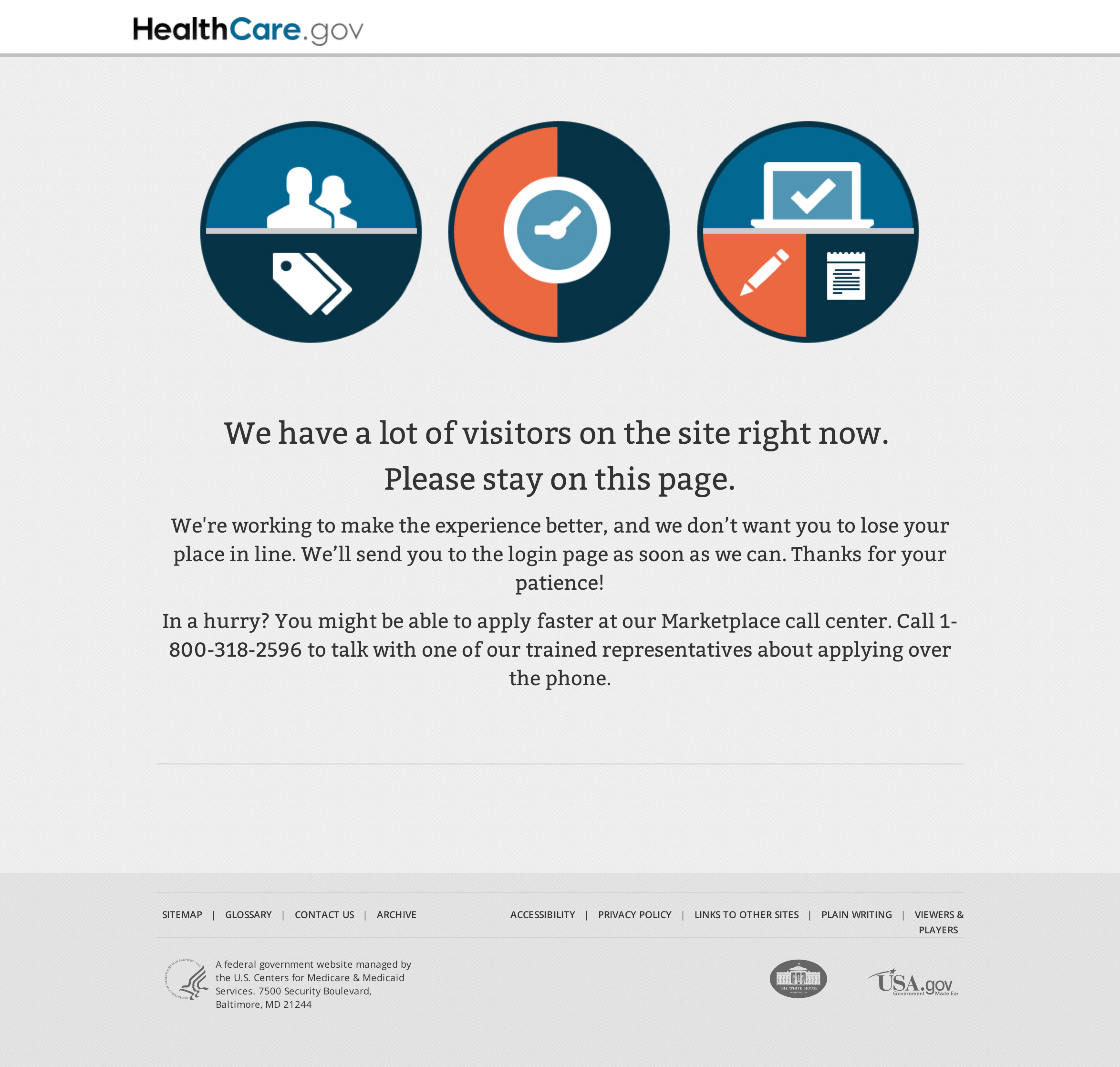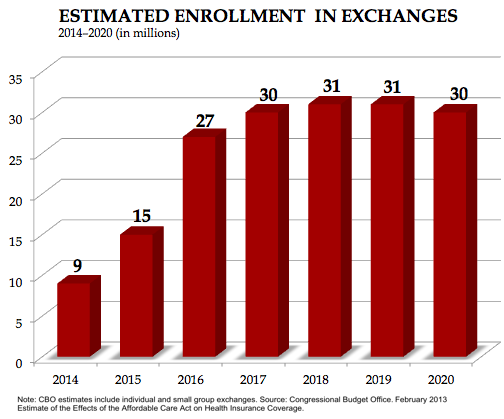Federal health insurance exchanges (also known as insurance marketplaces) are off to a slow start. As we await the first official enrollment figures in mid-November, however, it is important to recognize that a slow start is not a surprise. Most of those who have been forecasting exchange enrollment over the last year have assumed enrollment would grow over time with the increase of both awareness and penalties for remaining uninsured. The Congressional Budget Office (CBO), for example, projected that enrollment would build significantly over the first four years before stabilizing in 2017.
While the slow start is not necessarily troubling, the reason behind it is. Technical difficulties have plagued the federal exchanges. Those attempting to enroll have experienced long wait times, confusing error messages, and lost data. Many have been unable to log in to the web site, and some have even been unenrolled without their knowledge due to technology errors. Since it is difficult and time consuming to enroll in plans through the exchanges, those most likely to follow through on enrolling are those who need health coverage the most — older, sicker individuals. Young, healthy adults are disproportionately less likely to persist since they do not have acute health care needs, according to health care experts and insurance companies.[1]
While young, healthy adults are not the first group that comes to mind when most think about exchanges, they are arguably the most important. The success of health insurance exchanges hinges on the young and healthy enrolling to balance the risk and cost of older, sicker enrollees. Their participation will keep premiums low and health insurance exchanges viable.
These technology barriers are exacerbating an already important concern that too few young adults will enroll in health insurance exchanges. In Massachusetts, where a similar health reform was enacted in 2006, the uninsurance rate among young adults (aged 19-26) fell by more than 60% the following year.[2] The success of the Massachusetts exchange was driven by strong enrollment and awareness campaigns, including the support of the Red Sox.[3] Despite strong enrollment, however, the uninsured are still more than three times as likely to be young (aged 19-25). [4] The Massachusetts experience demonstrates the strong effort required to enroll the young and healthy, which the federal Department of Health and Human Services (HHS) recognizes. As Mandy Cohen from HHS explained to NPR this summer:
We also know that they’re most heavily marketed to, so it’s really hard to break through to this group [young adults]. . . We know we had to put an extra emphasis on the 18- to 35-year-old cohort. [5]
The stakes are high if young adults fail to enroll in health insurance exchanges. Health insurance companies will likely face higher costs than anticipated, and their profits are not all that will be lost. A failure to enroll the young and healthy could compromise the future success of exchanges. Insurance companies may raise their premiums or limit the number of plan options available for 2015. They could also decide to exit the exchange market altogether, further limiting options on the exchange.
Not only would higher premiums and fewer plan options inhibit young adults from enrolling in 2015, they could also raise the cost of operating exchanges for the federal government. Since exchange subsidies are based on premium costs, rising premiums will increase costs for beneficiaries as well as the federal government.
Doomsday for exchanges is not inevitable, though. HHS anticipates that the federal exchange website will be running smoothly by the end of November, and there are almost five more months of open enrollment with discussions on extending the open enrollment period. Given the significant negative press surrounding the federal technical difficulties, however, catching up on enrollment will require more than fixing the technology issues.
The federal exchanges will have to overcome the negative stigmas created by their high-profile technology issues. The negative stigmas are so pervasive that even state-run exchanges like California, which are not on the federal system, have expressed concern about a potential spillover effect. As Peter Lee, Executive Director of Covered California, explained
There is this real worry people who hear about glitches think that’s us and so don’t even try. I was at the Contra Costa Board of Supervisors and they were saying, “So our constituents are worried the system isn’t working because we hear the ability to enroll in the Affordable Care Act isn’t working.”[6]
Thus, while correcting the technical problems is necessary, it is not sufficient. The federal exchanges will need to regain public trust to overcome this negative press. Regaining the trust of the young and healthy will require aggressive, targeted enrollment campaigns, but it is key to getting federal health insurance exchanges back on track for the right kind of slow start.

[1] Weaver C and Martin T. Young Avoid New Health Plans: Early Buyers of Coverage Are Older Than Expected, Raising Expense Concerns. The Wall Street Journal. November 4, 2013. http://online.wsj.com/news/articles/SB10001424052702303661404579178231174626314
[2] Long S, Yemane A, and Stockley K. The Importance of Young Adult Provisions in Massachusetts’ Health Reform. State Health Access Data Assistance Center. August 2010. http://www.shadac.org/files/shadac/publications/MassReform2008YoungAdultsBrief.pdf.
[3] Whitney E. Insurance Pitch To Young Adults Started In Fenway Park. National Public Radio. July 8, 2013. http://www.npr.org/blogs/health/2013/07/09/200066175/baseball-obamacare-fenway-park.
[4] Blue Cross and Blue Shield of Massachusetts Foundation. March 11, 2013. http://bluecrossmafoundation.org/sites/default/files/Uninsured_in_MA_infographic_jpeg_0.jpg.
[5] Whitney E. Insurance Pitch To Young Adults Started In Fenway Park. July 8, 2013. http://www.npr.org/blogs/health/2013/07/09/200066175/baseball-obamacare-fenway-park.
[6]Terhune C. LA Times. http://www.latimes.com/business/la-fi-exchange-lee 20131030,0,2796100.story#axzz2jdydQd8V. October 29, 2013.
Photo credit: http://www.flickr.com/photos/factoryjoe/10143931475/sizes/o/in/photostream/


